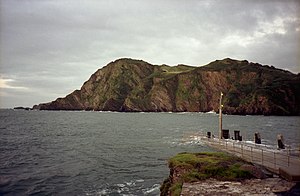Hillsborough, Devon

Hillsborough is a hill rising from a sea-cliff on the east side of Ilfracombe on the wild north coast of Devon, and the Iron Age hill fort on the hill top. It is also a local nature reserve.[1][2]
The hill is known locally, by its shape as seen from the harbour, as 'the sleeping elephant'. It was bought by the local council in the late nineteenth century to prevent development on the site. As well as a pleasant coastal area where visitors may roam, the remains of the Iron Age hill fort are there to be explored.
Location
- Location map:51°12’32"N, 4°6’11"W
The nature reserve
Hillsborough nature reserve, 'the sleeping elephant', is part of the North Devon's Biosphere Reserve, a predominantly agricultural region of north Devon centred on Braunton Burrows. Hillsborough is a rolling grassy cliff top area close to Ilfracombe.[3] It has been preserved by the local councill since its acquisition in the 1890s, to prevent its being developed.
The reserve provides an open access area with footpaths and natural scenery for the enjoyment of visitors and is traversed by the South West Coast Path. It is also part of the North Devon Areas of Outstanding Natural Beauty.[4]
The fort
The hill fort which gives Hillsborough its name is a Scheduled Ancient Monument. It is atop the cliff on a promontory at 375 feet above sea level. The fort takes the classic shape of a promontory reinforced and cut off landwards by a defensive earthworks.[5] These consist of two linear banks and ditches, oriented northwest to southeast, and contouring across the slope. For an Iron Age fort in northern Devon, the length of these banks, at 920 feet, is large.
There is a clearly-defined gateway near the eastern end of both banks, which is likely to have been the main entrance to the interior of the fort. Research using earth resistance and gradiometer surveys has produced good data, but interpretation is difficult because landscaping of the area was performed in Victorian times.[4]
This then is a multivallate fort and one of the two largest enclosures in Devon along with Cranmore Castle and marked by early Ordnance Survey maps at over 15 acres; but since the size of the enclosure today is less than half this, much of the enclosure must have been lost to coastal erosion since the early surveys.
References
- ↑ "Hillsborough". Natural England. http://www.lnr.naturalengland.org.uk/Special/lnr/lnr_details.asp?C=0&N=hillsborough&ID=218.
- ↑ "Map of Hillsborough". Natural England. http://magic.defra.gov.uk/MagicMap.aspx?startTopic=Designations&activelayer=lnrIndex&query=REF_CODE%3D%271008956%27.
- ↑ "Local Nature Reserves: Hillsborough LNR". North Devon Biosphere. http://www.northdevonbiosphere.org.uk/local-nature-reserves.html. Retrieved 16 August 2016.
- ↑ 4.0 4.1 "Unlocking our Coastal Heritage Hillsborough Hill Top Enclosure". South West Coast Path. https://www.southwestcoastpath.org.uk/. Retrieved 16 August 2016.
- ↑ Sellman, R.R.: 'Aspects of Devon History' (Devon Books, 1985) ISBN 0-86114-756-1. Chapter: "The Iron Age in Devon" (Map of Iron Age hill forts in Devon)